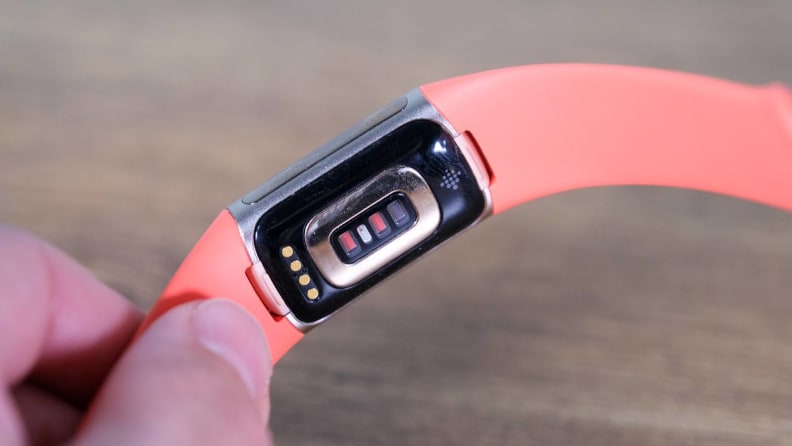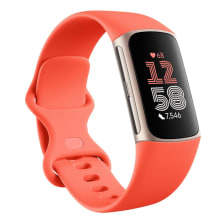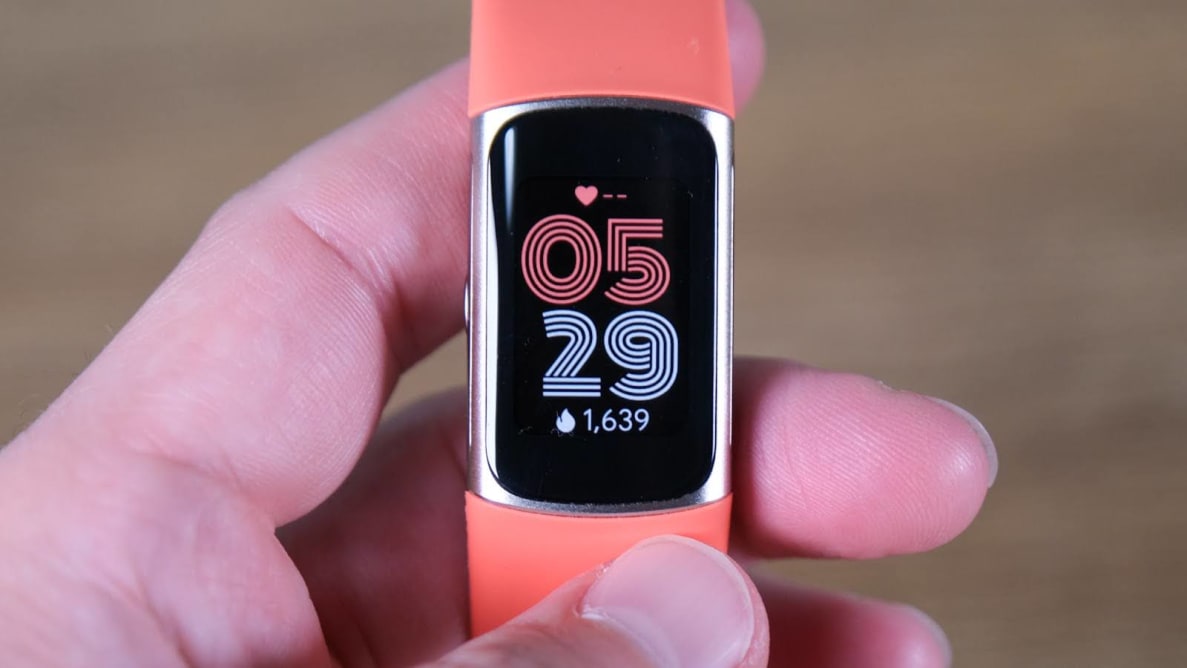Pros
-
Excellent fitness-tracking
-
Stylish design
-
Easy to use
Cons
-
Google services required for some features
-
Fitbit Premium subscription required for some features
At the time of this writing, it was one of the best dedicated fitness-tracking devices out there—with one caveat. To get the most out of this fitness band, it’s necessary to invest in a subscription to Fitbit Premium: the company’s subscription-based exercise instruction and tracking service. Those looking for more features than the Charge 6 provides would do well to consider upgrading to a smartwatch.
About the Fitbit Charge 6
Unlike many modern smartwatches, which come in different sizes, with or without cellular connectivity and premium build materials, there’s only one model of the Fitbit Charge 6. The only decision to make when buying the Fitbit Charge 6 is what color you want, which, depending on where you buy it from, should have no impact on pricing.
Fitbit Charge 6 specs
- Dimensions: 1.59 x 1.59 x 0.44 inches
- Display: 1.1-inch color AMOLED display
- Sensors: Heart rate monitor, ECG sensor, blood oxygen, accelerometer, ambient light sensor, GPS
- Water Resistance: 5ATM (Up to 50 meters)
- Battery: Seven days
- Compatibility: Android 9 or higher, iOS 15 or higher
- Colors: Obsidian / Black Aluminum, Porcelain / Silver Aluminum, Coral / Champagne Gold Aluminum
What we liked
Great fitness-tracking features

The Charge 6's sensors provide Blood Oxygen Level Monitoring, heart rate notifications and other useful health metrics.
The most important function of any fitness tracker is how well it tracks its users’ overall fitness. Thankfully, this is an area where the Fitbit Charge 6 excels.
The device has several sensors built into it to help users get a good picture of their activity and overall fitness. It has the basics, like a heart rate monitor and accelerometer for tracking steps, but it also offers some more advanced sensors—such as an ECG sensor and a blood oxygen sensor—that are often found in more expensive devices like the Apple Watch Series 9 or Google Pixel Watch 2.
The device also has GPS built into it, which generally works well. However, during testing it took longer to engage than we would have liked. If you want your entire workout to be geo-tracked, you’ll need to wait up to a minute for the Charge 6’s GPS to connect. It’s not an issue that the Apple Watch Ultra 2 suffers from. Then again, that device costs hundreds of dollars more.
During testing, the Charge 6’s heart rate monitor seemed mostly accurate. We wore the Polar H10 at the same time as the Charge 6 on three different runs and found that the Charge 6 always reported an average heart rate of within five heartbeats of the data that the Polar H10 collected (a device we use to collect baseline data, due to its accuracy). On one run, the Charge 6 reported an average heart rate of 144 bpm, while the Polar H10 reported a 148 bpm average.
Other Charge 6 fitness-tracking features proved helpful as well. The sleep-tracking data it collected was similar to that gathered by the Apple Watch Ultra 2, however unlike the Apple Watch, Fitbit provides users with a sleep score after a night’s rest. This data can be used to gauge trends over the days, weeks, and months that it is collected.
New for the Charge 6 is the ability to connect to gym equipment, allowing the device to broadcast heart rate to compatible machines. As someone who canceled their gym membership during COVID, I was unable to test this. The feature is built to work with the Bluetooth Heart Rate Profile, which is built into all kinds of different machines, including some of the latest machines from iFit, NordicTrack, Peloton, and Tonal.
The Fitbit app, available to download for free to iOS and Android smartphones, is well-designed and easy to use. Its user interface is split up into three tabs: Today, Coach, and You. For accessing health data, you’ll spend most of your time in the Today tab, while coaching and Fitbit’s library of workout videos can be found in the Coach tab. Unfortunately, you’ll need Fitbit Premium to access the content in this tab. However, if you workout at the gym or on your own, you may not want or care about this content enough to subscribe. We’ll get into the other Premium features later on. The You tab provides an overview of your fitness profile.
You can access your Charge 6 at the tap of a button from anywhere in the app, where you can change settings like the wearable’s clock face, add cards to Google Wallet, and set up Google Maps for the device.
Easy to navigate

The Charge 6 has useful features that can help make sense of your sleep patterns and collect data on your workouts so you don't have to.
We found the Charge 6’s user interface generally easy to navigate. There’s a haptic button on the side of the device that wakes it when it’s asleep, returns to the home screen when you’re not already there, or activates Google Wallet. We found that the button worked well, even while wearing gloves.
Using the Charge 6’s touch display proved just as easy. Swiping left or right from the home screen will take you to cards for notifications from your phone, exercise routines, YouTube Music, the ECG app, the EDA app for stress management, and Google Maps—offering turn-by-turn directions for cycling, walking, and driving. Swiping down from the home screen displays quick buttons for things like Sleep Mode, Do Not Disturb, and a button to jump into deeper Settings. Swipe up, and you’ll pull up activity information, including steps, heart rate, sleep information, and your Daily Readiness Score.
Sleek design

The band on this fitness watch is lightweight, slim and has a subtle design.
We really like the design of the Fitbit Charge 6. It’s sleek and stylish and, for its price point, well-made. Its display is big enough to show the information you need, thanks to its aforementioned well-designed software. And during testing, we found it to be relatively comfortable to wear.
The Charge 6 comes equipped with removable bands. Fitbit sells replacement bands in several colors. Amazon also sells a wide selection of third-party ones, which makes customizing this wearable a cinch. The bands are removed by pulling on a small clip, and it’s very easy to remove them when wanted, and difficult to remove them accidentally.
Good battery life
Maybe I’m too used to devices that need to be charged all the time. I recently reviewed the Galaxy Watch 6, and day to day use an Apple Watch Ultra 2. It makes me really appreciate a device that can last more than a few days on a charge. Fitbit rates the Charge 6 as offering up to seven days on a charge, and without the always-on-display enabled, that seemed more or less accurate.
What we didn’t like
Fitbit Premium required for some features
Part of my great experience with the Fitbit Charge 6 has to do with the fact that I had Fitbit Premium. You will too when you first get the tracker—six months of Premium is included. After that, Premium costs $10 per month or $80 per year.
Without a subscription, there are a few things that aren’t accessible. For starters, you won’t get your Daily Readiness Score, which is built to tell you whether your body is ready for a workout or you should prioritize rest. You also won’t get the wellness reports that wrap up all your data from the last 12 months, or more detailed sleep information (liek sleep phases) beyond a sleep score. If these features are important to you, you’ll need to pay to access them. Without paying, you’ll still be able to track your workouts and see information about those workouts, heart rate activity, and more (the full breakdown of the features is available at Fitbit’s website). I still find the tracker to be mostly worth it even without Premium, at least for those who simply want to track basic fitness metrics. The tracker is very good at tracking fitness, and while it will lock some of the analysis of that data behind Premium, not everyone needs to know what their “Daily Readiness Score” is.
Deep Google ecosystem integration
Google’s ownership of Fitbit is more apparent than ever on the Charge 6. In some cases, that’s a good thing—the device uses Google Maps to map your run. YouTube Music is baked into the device, and it’s not possible to use a third-party service like Spotify with it, and if you hope to use your Charge 6 with any other payment system than Google Wallet, prepare to be disappointed.
Not being able to use the wearable with any service but YouTube Music may irritate a lot of people. However, only having access to Google services, for some users, especially those who rely on an iPhone and Apple’s payment and music options, might find this to be a dealbreaker.
Should I buy the Fitbit Charge 6?

With a plentiful battery life, an attractive design and affordable price tag, this fitness tracker is an excellent buy.
Yes, for an inexpensive and capable fitness-tracking experience
For the price, you really can’t do much better than the Fitbit Charge 6, if you want a capable fitness tracker with some super helpful features.
The device tracks the most important fitness metrics, is easy to navigate, and looks good. You will get more advanced features if you’re willing to pay for a Premium subscription, like more detailed sleep data and a Daily Readiness Score. Of course, that is the big sticking point. At $80 per year, the tracker and Premium together cost $240 for the first year—however that’s still cheaper than most advanced devices, like smartwatches. Perhaps the big exception is the [Apple Watch SE], which doesn’t offer the same level of advanced fitness tracking.
Ultimately, however, whether you get the subscription or not the Fitbit Charge 6 is the best fitness tracker out there, and it comes at a reasonable price.

The Fitbit Charge 6 is an excellent health tracker, although it needs a subscription for full functionality.
Meet the tester
Christian de Looper is a consumer tech journalist with over a decade of experience. De Looper has covered all areas of the consumer tech industry, from smartphones to smart homes — and has attended all of the major trade shows, including CES.
De Looper has always been interested in consumer technology, but his love for gadgets and electronics blossomed into a full-blown passion when he started writing about it while completing his degree in audio production.
Since then, he has written for many of the top tech publications, including Digital Trends, Tom’s Guide, TechRadar, and many more. He loves getting his hands on all of the latest gadgets, but when he’s not reviewing tech, he can be found hanging out with his family or producing music.
Checking our work.
Our team is here to help you buy the best stuff and love what you own. Our writers, editors, and experts obsess over the products we cover to make sure you're confident and satisfied. Have a different opinion about something we recommend? Email us and we'll compare notes.
Shoot us an email





